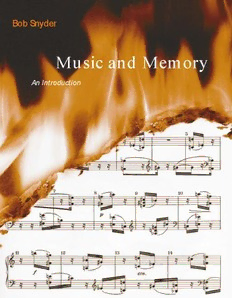Table Of ContentBob Snyder
Music and Memory Music and Memory
An Introduction
Bob Snyder
M An Introduction
This far-ranging book shows how human memory “This is a marvelous book.Snyder succeeds admirably
influences the organization of music.The book is in applying concepts and facts from psychological u
s
divided into two parts.The first part presents basic literature to music listening.The writing is excellent
i
c
ideas about memory and perception from cognitive throughout,lucid and insightful.”
a
psychology and,to some extent,cognitive linguistics. —Bruno Repp,Research Scientist,Haskins
n
Topics include auditory processing,perception,and Laboratories,New Haven,Connecticut
d
recognition.The second part describes in detail how
“This book is not only well-written and easy to read M
the concepts from the first part are exemplified in
but also extremely interesting and informative.I came
music.The presentation is based on three levels of e
away feeling as if my understanding of music had just m
musical experience:event fusion (the formation of
been reinvented in the context of cognitive theory.”
o
single musical events from acoustical vibrations in
—Lawrence W.Barsalou,Professor of Psychology, r
the air,on a time scale too small to exhibit rhythm), y
Emory University
melody and rhythm,and form.The focus in the latter is
on the psychological conditions necessary for making “I find the level and breadth of Music and Memory
large-scale—that is,formal—boundaries clear in music quite appealing.The book is perfect for music students
rather than on traditional musical forms.The book and artists interested in the temporal arts.”
discusses the idea that much of the language used —Stephen McAdams,Music Perception and Cognition S
n
to describe musical structures and processes is Team,Institut de Recherche et de Coordination
y
metaphorical.It encourages readers to consider the Acoustique/Musique (IRCAM) and Centre National d
possibility that the process of musical composition de la Recherche Scientifique (CNRS),Paris e
r
can be “a metaphorical transformation of their own
Cover music: Varationen for the piano,op.27 by Anton Webern.
experience into sound.”
© 1937 Universal Edition AG.Copyright renewed.All rights
The book also touches on unresolved debates about reserved.EAMD LLC.Used by permission.Miami,FL 33014
psychological musical universals,information theory,
The MIT Press
and the operation of neurons.It requires no formal Massachusetts Institute of Technology
musical training and contains a glossary and an Cambridge,Massachusetts 02142
appendix of listening examples. http://mitpress.mit.edu
SNYMP 0-262-69237-6
Bob Snyder is a composer and video artist and Chair ,!7IA2G2-gjcdhd!:t;K;k;K;k
of the Sound Program at the School of the Art Institute
of Chicago.
Music and Memory
Music and Memory
An Introduction
Bob Snyder
The MIT Press
Cambridge, Massachusetts
London, England
© 2000 Massachusetts Institute of Technology
All rights reserved. No part of this book may be reproduced in any form by any electronic
or mechanical means (including photocopying, recording, or information storage and
retrieval) without permission in writing from the publisher.
This book was set in Sabon by Best-set Typesetter Ltd., Hong Kong and was printed and
bound in the United States of America.
Library of Congress Cataloging-in-Publication Data
Snyder, Bob, 1946–
Music and memory: an introduction / by Bob Snyder.
p. cm.
Includes bibliographical references (p.) and index.
ISBN 978-0-262-19441-9 (hc. : alk. paper)—978-0-262-69237-3 (pbk. : alk. paper)
1. Music—Psychological aspects. 2. Memory. 3. Music—Theory, Elementary. I.
Title.
ML3830 .S56 2000
781¢.11—dc21
99-086731
10 9 8 7 6
For Roger Gilmore, who gave me a chance
Contents
Preface xiii
Structure of the Book xvii
Acknowledgments xx
List of Illustrations xxi
I Some Cognitive Concepts 1
1 Auditory Memory: An Overview 3
Memory Diagram 5
Memory and Time Levels of Musical Experience 1:
Level of Event Fusion 12
Memory and Time Levels of Musical Experience 2:
Level of Melodic and Rhythmic Grouping 13
Memory and Time Levels of Musical Experience 3: Level of Form 14
2 Echoic Memory and Early Processing 19
Feature Extraction and Perceptual Binding: Perceptual Categorization 19
Representation and Recognition 23
Habituation: A Special Form of Recognition 23
Brain Processes and Musical Time 25
3 Grouping 31
Primitive and Learned Grouping 32
Primitive Grouping 33
Grouping and Short-Term Memory 34
Groupings and Phrases 37
Proximity 39
Similarity 40
Continuity 42
viii Contents
Higher-Level Grouping Factors 43
Set 45
4 Short-Term and Working Memory 47
Limitations of Short-Term Memory 49
Focus of Conscious Awareness 51
Rehearsal 52
Chunking 53
5 Closure 59
Intensity and Metaphors of Motion and Gravity 62
Linearity: A Metaphor of Causality 63
Repetition 65
6 Long-Term Memory 69
Implicit Memory 72
Explicit Memory 74
7 Categories 81
Perceptual Categories 82
Conceptual Categories 83
Categories and Nuance 85
Nuance and Implicit Memory 87
8 Schemas: Frameworks for Experience and Memory 95
Schematic Organization 97
Schemas and Normalcy 98
Schemas and Music 100
Schemas as Musical Frameworks 101
Schemas and Musical Culture 102
Speculations about Schemas and Perception 103
9 Metaphor 107
Image Schemas 108
Image Schemas and Music 110
“Up” and “Down”: Music and Gravity 111
Centrality in Music 112
Motion-Linkage-Causation 113
Linearity: Paths and Goals 114
Containment: Inside and Outside 115
Contents ix
Metaphorical Extension 116
Other Metaphorical Possibilities 117
II Some Musical Concepts 121
10 Event Fusion 123
Pitched Events 124
Pitch Discrimination and Memory 127
Interval 129
The Octave: A Special Interval 130
11 Melody 135
A Basic Melodic Category Structure: Tuning System 136
Melodic Category Structure: Scales 139
Scales and Short-Term Memory 140
Scales, Categories, and Schemas 140
Scales, Categories, and Nuance 141
Blurring Pitch Categories: Ornamentation 143
Melodic Grouping and Streaming 143
Melodic Motion 146
Contour 149
Continuous Contour 150
A System of Melodic Organization: Tonality 151
Tonality and Implicit Memory 152
Melodic Schemas 152
Image Schemas and Melody 154
Axial Melodies 154
Melodic Arch 154
Melody and the Filling of Gaps 155
12 Rhythm 159
Basic Rhythmic Concepts 159
Rhythm and Short-Term Memory 161
Beats 162
Pulse 163
Pulse as Temporal Category 165
Tempo 167
Accent 170

